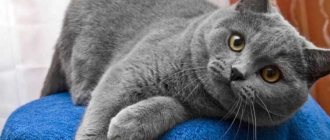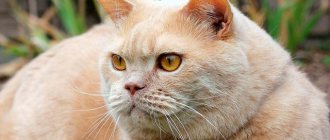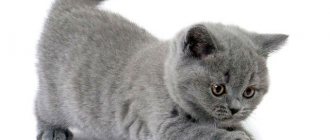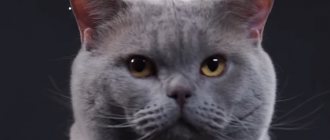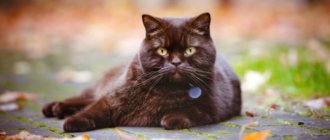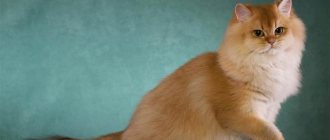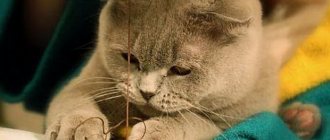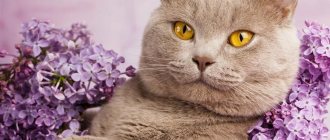Review author: “ZooVita”
The main distinguishing feature of this cat breed, from which it got its name, is its short hair, the appearance of which can be seen in the photo of a British Shorthair cat. There is no exact information about the homeland of this beautiful cat.
According to some sources, she appeared in France, while other sources claim that she is a descendant of Egyptian cats. The first exhibition at which this breed was presented took place in England in 1871.
After this exhibition, breeders and cat lovers paid attention to the British Shorthair, being impressed by the beauty of its dense coat.
The cat gained worldwide fame and distribution only in the 20th century, and was brought to the Russian Federation in 1980. Currently, the breed is popular all over the world.
Appearance of the British Shorthair cat
The description of the British Shorthair cat can begin with the fact that despite its rather large size, it has truly feline grace and elegance. This breed attracts with its beautiful, deep look and velvety coat, which is very pleasant to the touch and appearance.
If necessary, the British Shorthair can be a good hunter. The weight of representatives of the breed can range from four to eight kilograms.
He has fairly broad shoulders, a chest and a powerful body. The round and wide head has a short nose. The eyes are also round, the color of which depends on the type of breed and can be orange, blue or green.
The paws are small, but massive with thick claws. The tail has a rounded end, thickened at the base. The ears of British Shorthairs should be straight and erect, this indicates the purebred of the individual. The coat has a dense undercoat and is short and dense.
Story
The first mentions of this breed are found in ancient chronicles. There is no documented information about their origin. The first very large rat-catching cats were brought in by Roman centurions. Researchers suggest that cats were introduced by the Romans during an attack on the British Isles in 43 AD. e. In Britain they were called the “British cat”, in France - “Charteuse”, in Germany - “Carthusian cat”.
The animals were used as rodent hunters, but by the end of the 16th century, breeders paid attention to the appearance of cats. The British attended the first London cat show in 1871. Then official breed standards were adopted, and felinology began its rapid development.
The first British appeared in Russia in 1992, along with the Cartheusers, who are now called in Russia “the old type of British.”
To consolidate the unique features of the British, breeders used Persian cats - which is why British cats have a slightly flat face.
Types of colors of the British Shorthair cat
The most common color is blue. But the colors of the British Shorthair cat are very diverse:
Solid color
The cat's fur, like its skin, should be the same color. The most widely represented color is blue, but other options are possible: black, lilac, chocolate, red and white. The rarest solid colors of the British Shorthair cat are: cinnamon and fawn.
The black color combines surprisingly beautifully with yellow eyes. The lilac color is artificially bred. The value of a chocolate-colored cat becomes higher depending on the intensity of its shade.
In short-haired dogs with a red color, the intense color is considered valuable. The White British Shorthair cat is very difficult to breed and has a high risk of giving birth to offspring with defects.
The rarest color of the cat's color - "Cinnamon" - is very much appreciated by lovers of the breed. But the rarest of the colors is considered to be “Faun”. This color is valuable because it makes it possible, during breeding, to produce offspring of new light shades.
Tortoiseshell color
Basically, females are endowed with this complex and beautiful color, while males, if they have a tortoiseshell color, are sterile. Particularly appreciated is the presence of red or cream shades on the cat’s face in this color.
Silver and golden color
Cats with such a magnificent color are also called British chinchillas. The British species with this coloring is one of the rare and most expensive.
Eye color typical for silver cats: blue, lilac or green. Individuals with a golden color are considered defective if there is a gray undercoat.
Color Point
The similarity of the British Shorthair Color Point with cats of the Siamese breed is due to the characteristic coat colors: basic white in combination with black, chocolate or red.
Tabby
An amazing feature of the British Tabby color is the presence of patterns on the coat in the form of symmetrical stripes and spots on any non-primary color. Tabby cats are very similar to tigers or leopards.
"Whiskas"
A valuable type of color, characterized by clear stripes covering the entire body of the cat, is the Whiskas color. The pattern should be as clear and contrasting as possible.
Bicolor or "Harlequin"
The peculiarity of the color is the presence of two colors, the predominant of which is white. The additional color may not be uniform and may have patterns.
Bicolor colors
The group includes combinations of white and other colors.
Also, two colors can be combined with white (tri-color color).
Bicolor colors are divided into 3 groups depending on the proportions of the colors.
- Van is an almost white animal, only the tail or spots on the head are colored.
British kitten blue van
British cat blue cream van
- Harlequin - white makes up approximately 4/5 of the surface of the body, and there are large colored markings on the back and head.
British cat black harlequin
British cat lilac harlequin
- Bicolor - about half of the body is painted white.
The picture shows a British cat chocolate-red bicolor
British bicolors must have white muzzle, collar, hips and paw pads.
British kitten blue bicolor
Their eyes are copper or golden in color.
Personality traits of the British Shorthair cat
Despite the fact that British Shorthair cats tolerate loneliness quite painlessly, they yearn for an absent owner. Preferring independence, cats of this breed become attached to one person.
The cat prefers to avoid strangers, occasionally responding to obsessive attention with aggression. Possessing self-esteem, representatives of the British Shorthair are extremely restrained and not intrusive.
They have a minimal need for affection from their owner. He has a calm disposition and even in the event of aggression, he does not immediately use his claws, but only warns with a blow of a soft paw.
If there is a special claw scratcher, the cat, due to its good manners, will not damage the furniture. She is very selective in choosing her favorite places, which are always central in the home.
Representatives of the breed are very playful and prefer to have several toys. They respond well to training at an early age; it is almost impossible to retrain an adult cat.
The “British” devote quite a lot of time to their appearance, carefully licking themselves throughout the day. There are no problems when toilet training a cat, since this breed is very clean and the only nuance may be the individual selection of litter for the tray.
Animal mating
Representatives of this breed belong to individuals with a late indicator of the development of reproductive systems.
Therefore, knitting a cat in its first year of life is strictly prohibited, because the animal may simply die. The body completes full development only by the age of 6 years.
Early mating of males before 2 years of age can lead to exhaustion, so in the future they will not be able to produce offspring.
British kittens are born completely similar to adults. Physiological features in the form of a disproportionate body are the norm for kittens. Over time, everything will return to normal, and the kitten will take on the appearance of a standard British cat.
Oriental cat - history of the breed, modern standards, character, care, nutrition + 83 photos- Maine Coon - history of occurrence, description of the breed, character + 84 photos
- Burma - a cat as a mascot, hygiene and health, character of the breed + 96 photos
Nutrition and care of the British Shorthair cat
Although caring for a British Shorthair cat is not tedious, it does require some time. To maintain the appearance of the coat, it is necessary to comb the cat several times a week. You should not bathe your pet more than twice a year. You need to clean your ears and trim your nails at least once a month.
The diet of this breed, like others, must be balanced and contain all the necessary vitamins and minerals. Proper nutrition will help maintain your cat's health and appearance at a high level.
It is acceptable to feed your pet prepared food, but preference should be given to reputable manufacturers. Foods containing salt and sugar can be harmful to your cat.
White
White beauties are incredibly gentle and soft. The skin has a light pink color. Often these are British people with blue eyes, but in some you can see aquamarine and even multi-colored. The animals' fur is so snow-white that it resembles ice shimmering in the sun or freshly fallen snow. The color can easily be classified as cold. Some people confuse this shade with yellowish, believing that this is the norm, but this is not the case. In the case when white turns into some other color or resembles more flesh-colored, it is no longer classified as this color.
Photo of British Shorthair cat
Chocolate
You might think that most black cats turn chocolate over time, but this is not true. Babies, whom nature has endowed with such a shade, have a deep tone in childhood, but not very saturated. The beautiful chocolate shade makes itself felt in six months. The color is so monotonous that sometimes it is impossible to describe it in words. Breeders say that the cost is affected by the depth of color. In some countries, chocolate Britons are also called chestnut or havanna.
